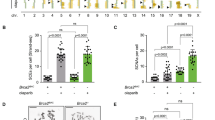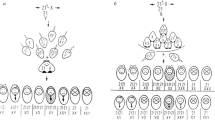Abstract
THE role of chromatid exchange in the origin of chromosome aberrations has been a subject of research since the chromatid exchange hypothesis of chromosome aberrations was proposed1. Which of the breakage–treunion hypothesis2 and the exchange hypothesis better explains the origin of chromosome aberrations is still disputed3,4. The part played by DNA repair in aberration and exchange formation has been identified5,6, and there is much evidence for non-random distribution of chromosome aberrations, especially in the heterochromatic regions7,8. We have shown previously by autoradiography, that sister chromatid exchanges (SCEs) induced by 7,12-dimethylbenz(a)anthracene (DMBA) are frequently associated with aberrations8. Newly introduced 5-bromodeoxyuridine(BUdR)–33258 Hoechst methods for SCEs9,10 have made it possible to reanalyse these problems in more detail and with considerable accuracy. The results presented here indicate that two different hydrocarbon carcinogens, DMBA and 7,8,12-trimethylbenz(a)-anthracene (TMBA), induce aberrations localised in the same chromosomal regions of the rat bone marrow cells and that the targets for chromosome aberrations and for SCE are identical; in other words, both phenomena are related.
This is a preview of subscription content, access via your institution
Access options
Subscribe to this journal
Receive 51 print issues and online access
$199.00 per year
only $3.90 per issue
Buy this article
- Purchase on Springer Link
- Instant access to full article PDF
Prices may be subject to local taxes which are calculated during checkout
Similar content being viewed by others
References
Revell, S. H., in Proc. Radiobiol. Symp., Liège, 1954 (edit. by Bacq, Z. M., and Alexander, P.), 243–253 (Butterworths, London, 1955).
Sax, K., Genetics, 23, 494–516 (1938).
Heddle, J. A., Whissel, D., and Bodycote, D. J., Nature, 221, 159–160 (1969).
Commings, D. E., in Chromosomes and Cancer (edit. by German, J.), 95–133 (John Wiley, New York, London, Sydney, and Toronto, 1974).
Perry, P., and Evans, H. J., Nature, 258, 121–125 (1975).
Latt, S. A., Proc. natn. Acad. Sci. U.S.A., 71, 3162–3166 (1974).
Natarajan, A. T., and Ahnström, G., in Modern Aspects of Cytogenetics Constitutive Heterochromatin in Man (edit. by Pfeiffer, R. A.), 215–223 (F. K. Schattauer Verlag, Stuttgart and New York, 1973).
Sugiyama, T., J. natn. Cancer Inst., 47, 1267–1275 (1971).
Latt, S. A., Proc. natn. Acad. Sci. U.S.A., 70, 3396–3399 (1973).
Perry, P., and Wolff, S., Nature, 251, 156–158 (1974).
Goto, K., Akematsu, T., Shamazu, H., and Sugiyama, T., Chromosoma, 53, 223–230 (1975).
Sugiyama, T., Gann, 64, 637–639 (1973).
Author information
Authors and Affiliations
Rights and permissions
About this article
Cite this article
UEDA, N., UENAKA, H., AKEMATSU, T. et al. Parallel distribution of sister chromatid exchanges and chromosome aberrations. Nature 262, 581–583 (1976). https://doi.org/10.1038/262581a0
Received:
Accepted:
Issue Date:
DOI: https://doi.org/10.1038/262581a0
This article is cited by
-
On the origin of chromosomal aberrations in human peripheral lymphocytes in vitro
Human Genetics (1984)
-
Evidence that sister chromatid exchanges and chromatid breaks are two independent events
Chromosoma (1982)
-
Localisation of 7-12-Dimethylbenz(a)anthracene induced chromatid breaks and sister chromatid exchanges in chromosomes 1 and 2 of bone marrow cells of rat in vivo
Chromosoma (1980)
-
Analysis of a BrdU-sensitive site in the cactus mouse (Peromyscus eremicus): chromosomal breakage and sister-chromatid exchange
Chromosoma (1980)
-
Reduced N-methyl-N?-nitro-N-nitrosoguanidine sister chromatid exchange induction in chinese hamster V79 cells pre-exposed to 5-bromodeoxyuridine
Chromosoma (1980)
Comments
By submitting a comment you agree to abide by our Terms and Community Guidelines. If you find something abusive or that does not comply with our terms or guidelines please flag it as inappropriate.



